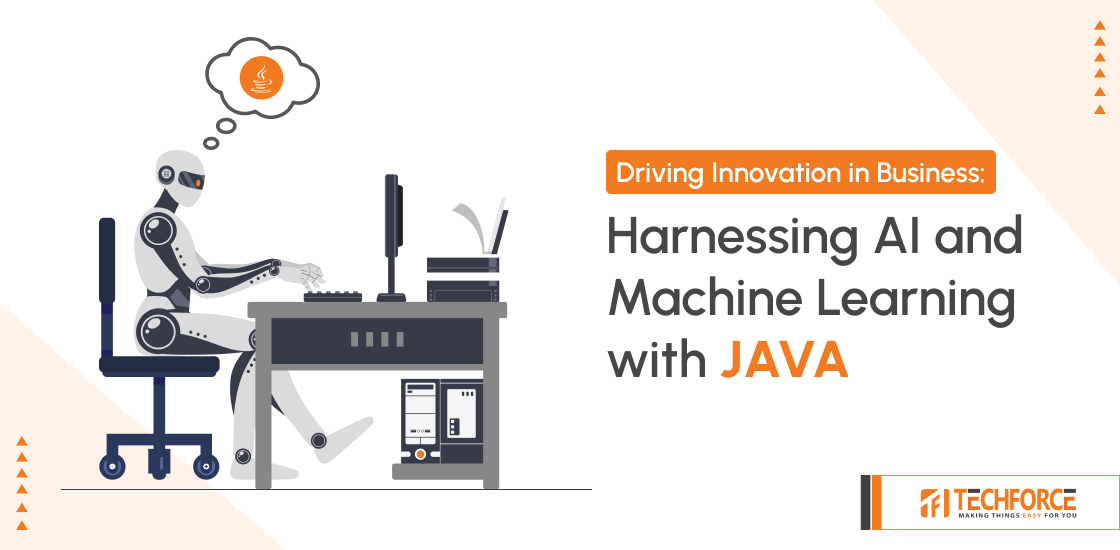Driving Innovation in Business: Harnessing AI and Machine Learning with Java
From Java Foundations to AI Innovations: A Comprehensive Guide to Machine Learning
Introduction
Overview of AI and Machine Learning
Artificial Intelligence (AI) and Machine Learning (ML) have become the cornerstone of modern technology. From recommending the next video on your favorite streaming service to predicting stock market trends, AI and ML are transforming the way we live, work, and play. But before we dive into the nitty-gritty of implementing AI and ML using Java, let’s demystify these buzzwords a bit.
Artificial Intelligence (AI) involves creating machines that can perform tasks requiring human-like intelligence. These tasks include learning from data, reasoning to make decisions, and correcting themselves. Machine Learning (ML), a subset of AI, focuses on developing algorithms that enable computers to learn from and make predictions based on data. It’s like teaching your computer to fish rather than just giving it a fish.
Importance of AI in Modern Applications
In today’s world, AI isn’t just a fancy add-on; it’s a necessity. Businesses are leveraging AI to enhance customer experiences, optimize operations, and even create new revenue streams. Think of AI as your secret weapon, like Batman’s utility belt but with fewer grappling hooks and more data crunching.
From chatbots that offer 24/7 customer support to AI-powered analytics that can predict market trends, the importance of AI in modern applications cannot be overstated. Companies that harness the power of AI are often the ones that lead their industries, while those that don’t risk being left behind.
Why Use Java for AI?
When it comes to AI and ML, the programming language you choose can significantly impact your project’s success. While Python often steals the spotlight, Java is a strong contender that’s worth your attention. Why Java, you ask? Well, Java brings several advantages to the table, which we’ll explore in the next section.
Java and AI: A Perfect Match
Benefits of Using Java for Machine Learning
Java is like the Swiss Army knife of programming languages—versatile, reliable, and packed with features. Here are some compelling reasons to consider Java for your AI and ML projects:
- Platform Independence: Write once, run anywhere. Java’s platform independence means you can develop your application on any device and run it anywhere, be it on a server, desktop, or mobile device.
- Scalability: Java is built for large-scale systems. Its scalability ensures that your AI application can grow and handle increased loads without a hitch.
- Performance: Java’s performance is another strong point. While it may not match the raw speed of C or C++, it’s faster than Python and offers a good balance between development speed and execution speed.
- Community Support: A large and active community means extensive libraries, frameworks, and tools are available to support your development efforts.
Overview of Java’s Ecosystem for AI
Java boasts a rich ecosystem that supports AI and ML development. From robust libraries to powerful frameworks, Java provides everything you need to get started with AI. Some notable mentions include:
- Deeplearning4j: A deep learning library for Java that supports neural networks and machine learning. It’s perfect for building sophisticated AI models.
- Weka: A collection of machine learning algorithms for data mining tasks, Weka is easy to use and integrates well with Java.
- MOA (Massive Online Analysis): Ideal for data stream mining, MOA is designed for analyzing large-scale data in real-time.
- Java-ML: A machine learning library with a focus on simplicity and ease of use. It’s great for beginners and offers a wide range of algorithms.
Getting Started with Machine Learning in Java
Setting Up Your Java Environment for AI Development
Before diving into coding, you need to set up your development environment. Here’s a step-by-step guide to get you started:
- Install Java Development Kit (JDK): Make sure you have the latest JDK installed on your machine. You can download it from the official Oracle website.
- Integrated Development Environment (IDE): An IDE like IntelliJ IDEA or Eclipse can make your life easier with features like code completion, debugging, and more.
- Maven or Gradle: These build tools help manage your project’s dependencies and streamline the build process. Maven is particularly popular in the Java ecosystem.
Introduction to Popular Java AI Libraries
Now that your environment is ready, let’s look at some popular AI libraries in Java:
- Deeplearning4j: This library is perfect for deep learning. It supports various neural network architectures and integrates well with Hadoop and Spark.
- Weka: Known for its ease of use, Weka offers a graphical user interface along with a rich collection of algorithms.
- MOA: If your project involves real-time data analysis, MOA is your go-to library. It’s designed for processing large data streams efficiently.
- Java-ML: This library focuses on simplicity and provides a wide range of algorithms for clustering, classification, and more.
Simple Machine Learning Example
Building a Basic Machine Learning Model in Java
Let’s get our hands dirty with some code. We’ll build a simple machine learning model using Weka to classify iris flowers based on their attributes.
- Add Weka to Your Project: If you’re using Maven, add the following dependency to your pom.xml file:
xml
<dependency>
<groupId>nz.ac.waikato.cms.weka</groupId>
<artifactId>weka-stable</artifactId>
<version>3.8.5</version>
</dependency>
- Load Dataset: First, download the iris dataset from UCI Machine Learning Repository. Then, load it into your Java project:
java
import weka.core.Instances;
import weka.core.converters.ConverterUtils.DataSource;
public class IrisClassifier {
public static void main(String[] args) throws Exception {
DataSource source = new DataSource("path/to/iris.arff");
Instances data = source.getDataSet();
data.setClassIndex(data.numAttributes() - 1);
}
}
- Build Classifier: Choose a classifier and build your model. We’ll use the J48 decision tree classifier:
java
import weka.classifiers.Classifier;
import weka.classifiers.trees.J48;
public class IrisClassifier {
public static void main(String[] args) throws Exception {
DataSource source = new DataSource("path/to/iris.arff");
Instances data = source.getDataSet();
data.setClassIndex(data.numAttributes() - 1);
Classifier classifier = new J48();
classifier.buildClassifier(data);
System.out.println(classifier);
}
}
- Evaluate Model: Evaluate your model’s performance using cross-validation:
java
import weka.classifiers.Evaluation;
import weka.core.Utils;
public class IrisClassifier {
public static void main(String[] args) throws Exception {
DataSource source = new DataSource("path/to/iris.arff");
Instances data = source.getDataSet();
data.setClassIndex(data.numAttributes() - 1);
Classifier classifier = new J48();
classifier.buildClassifier(data);
Evaluation eval = new Evaluation(data);
eval.crossValidateModel(classifier, data, 10, new java.util.Random(1));
System.out.println(eval.toSummaryString("\nResults\n======\n", false));
}
}
Congratulations! You’ve built a basic machine learning model in Java. See, it wasn’t that hard, was it?
Future Trends in Java and AI
Emerging Trends and Technologies
The future of Java in AI looks promising, with several emerging trends and technologies on the horizon:
- Edge Computing: As IoT devices proliferate, there’s a growing need to process data closer to where it’s generated. Java’s platform independence makes it ideal for edge computing applications.
- Explainable AI (XAI): With increasing scrutiny on AI decisions, there’s a push towards making AI models more interpretable. Java’s robust ecosystem can support the development of XAI applications.
- AI-Driven Development: Tools that use AI to assist in software development are gaining traction. Java’s extensive use in enterprise applications positions it well to benefit from these advancements.
Predictions for the Future of Java in AI
Looking ahead, Java is set to play a significant role in the AI landscape. With continuous improvements to its performance and scalability, Java will remain a top choice for developing large-scale AI applications. Additionally, as AI technologies evolve, we can expect to see more specialized libraries and frameworks tailored for Java, further solidifying its position in the AI world.
Conclusion
Summary of Key Points
In this blog, we explored the fascinating world of AI and machine learning with Java. We discussed the importance of AI in modern applications, the benefits of using Java for AI projects, and provided a step-by-step guide to building a simple machine learning model using Weka.
Encouragement to Explore AI with Java
Java offers a powerful, scalable, and versatile platform for AI development. Whether you’re a seasoned developer or just starting out, Java’s extensive ecosystem and strong community support make it an excellent choice for your AI projects. So, why not dive in and start exploring the exciting possibilities of AI with Java today? Who knows, you might just create the next big thing in AI—and have some fun along the way!
For more insights into how AI can transform your business, visit our AI solutions page. If you’re interested in leveraging Java for your next big project, check out our Java development services.
Disclaimer: This blog is copyright-free and original. Any resemblance to other content is purely coincidental. Let’s keep the plagiarism gremlins at bay!
 Manish Mori
19 Jul 2024
Manish Mori
19 Jul 2024
 US +1 (630) 296 6606
US +1 (630) 296 6606
 India +91 (79) 48904529
India +91 (79) 48904529
 Poland +48 (730) 059 665
Poland +48 (730) 059 665
 reach@techforceglobal.com
reach@techforceglobal.com
 +1 630 303 7389
+1 630 303 7389

 Calendly
Calendly
 LinkedIn
LinkedIn
 Whatsapp
Whatsapp
 Fintech
Fintech
 Education
Education
 Ecommerce
Ecommerce
 Healthcare
Healthcare
 Travel and Hospitality
Travel and Hospitality
 Public Sector
Public Sector




